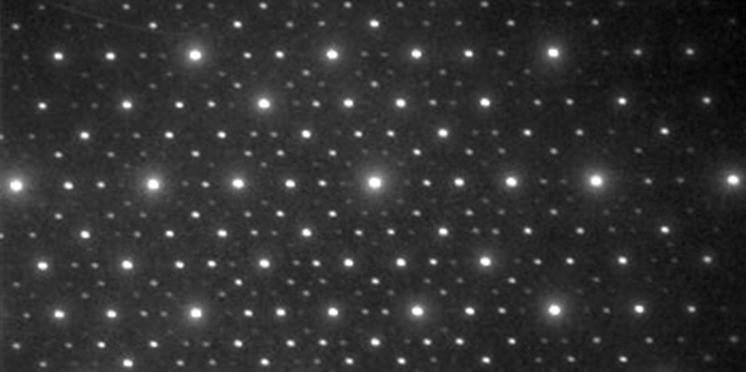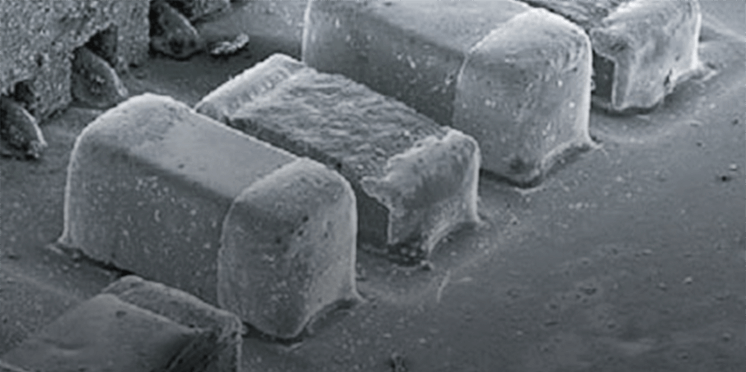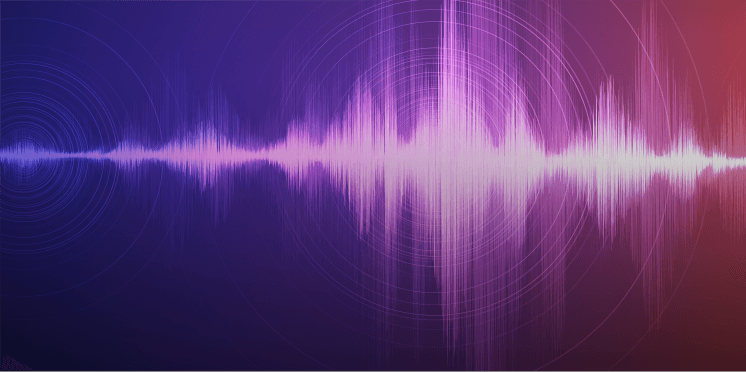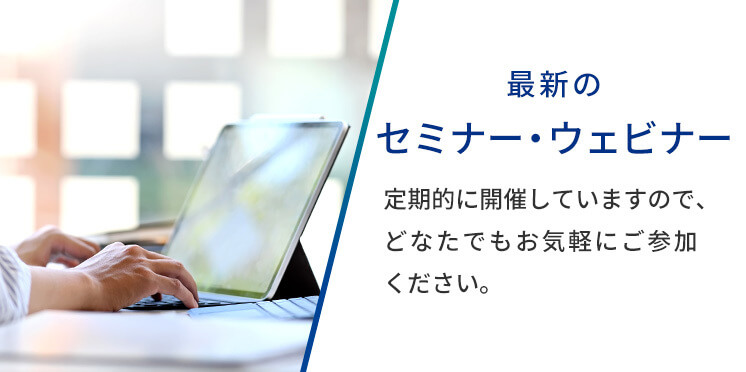ロンチグラム
ロンチグラム
Ronchigram
[目次:理論(電子の散乱/回折/結像)]
照射系レンズによって電子線を試料付近に収束させて、回折面上にできる試料の投影像(図形)のことをロンチグラムという。照射系レンズによって試料付近にできた収束電子線プローブの光学的特性(収差の程度)を知ることができる。STEMにおいて入射電子線の試料への焦点あわせや、プローブの収差のない角度範囲の確認、非点(軸上)収差の補正等に用いられる。
入射電子線プローブの収束点が試料に近づくにつれて、ロンチグラム内に見られる試料像(図形)の倍率がしだいに大きくなる。プローブの収束点が試料上に正しく合うと(正焦点)ロンチグラムの倍率は無限大になり、アモルファス試料が用いられた場合は、その強度が一様な像になる。ロンチグラムの強度が一様になるところを探すことで、入射電子線を試料上に正しく合わせられたことを確認できる。また、ロンチグラムの強度が一様になる入射角度領域の大きさから入射プローブの収差のない角度範囲がわかり、プローブの良さの判定ができる。三次の球面収差補正なしの場合では、強度の一様な領域が小さな円の中に制限されるが、補正した場合には、強度が一様の領域が大きくなる。このことは、収差補正によって試料上の一点に収束される電子線の角度領域が広がったことを意味している。
結晶性試料を用いた場合、その結晶の格子面からの回折角より大きな角度の入射電子線を正焦点から少しずれた照射によって得られるロンチグラムには、結晶格子による干渉パターンが現れる。干渉パターンの中に結晶の格子面による縞が観察されれば、入射電子線のプローブ径が、格子面間隔より小さくなっていることを示しており、STEM観察に用いる入射プローブの焦点上での大きさを知ることができる。
ロンチグラムは元来、光学におけるレンズの性能を検査するために提案されたもので、その名称は、この方法を提案したV. Ronchiに由来する。
Ronchigram ⇒図
図(a) ロンチグラムの光線図。 図(b)、図(c) アモルファス薄膜試料からのロンチグラム図形。収差補正なしの場合(図(b))では、強度の一様な領域が小さな円の中(半角~11mrad)に制限されている。一方、収差補正を施した場合(図(c))には、強度が一様の領域が大きくなっている(半角~45mrad)。
A Ronchigram is a projection image (pattern) of a specimen formed on the diffraction plane with a convergent incident electron beam focused near the specimen using a probe-forming lens. The Ronchigram enables us to determine the optical characteristics (amount of aberration) of the electron probe formed near the specimen using the probe-forming lens. The image is used to obtain the exact focus of the incident electron probe onto the specimen in STEM observations, to know the angular range of the electron probe with no aberration, and to compensate the axial astigmatism.
When the convergence point of the incident electron probe becomes closer to an amorphous specimen, the magnification of the specimen-shadow image (pattern) seen in the Ronchigram is increased. When the convergence point of the probe is exactly focused onto the specimen, the magnification of the Ronchigram or the shadow image becomes infinite and its intensity becomes uniform. By adjusting the Ronchigram to have a uniform intensity, the exact focus of the incident beam onto the specimen is confirmed. Measurement of the angular range of the area with a uniform intensity in the Ronchigram allows us to determine the angular range of the incident probe with no aberration or to know the quality of the electron-probe. If the third-order spherical aberration is not corrected, the area with a uniform electron intensity is confined to a small extent. When the aberration is corrected, the area is largely extended. This means that the angular range of the electron beam focused onto a point of the specimen is expanded due to vanishing of the aberration.
The Ronchigram obtained using a crystalline specimen exhibits interference fringes, when the incident beam with an incidence angle larger than the diffraction angle from a lattice plane of the crystal is illuminated onto the specimen with a small defocus. Appearance of the interference fringes means that the probe diameter on the focal plane is smaller than the lattice spacing. From this experiment, the probe size on the focal plane used for STEM observations can be known.
The term “Ronchigram” is named after V. Ronchi, who proposed the method to originally examine the performance of a lens of light optics.

Fig. (a) Ray diagram of Ronchigram.
Fig. (b), Fig. (c) Ronchigram patterns obtained from an amorphous thin-film specimen. In the case of no aberration correction (Fig. (b)), the area with a uniform electron intensity is confined to a small extent (semi-angle: ~11 mrad). When the aberration is corrected (Fig. (c)), the area is largely extended (semi-angle: ~45 mrad).
関連用語から探す
説明に「ロンチグラム」が含まれている用語






